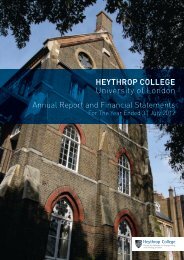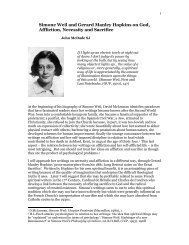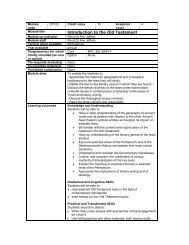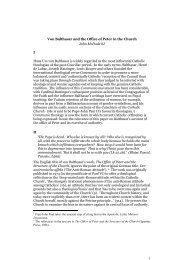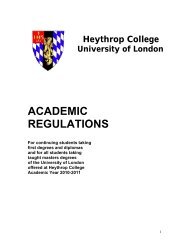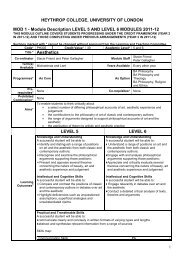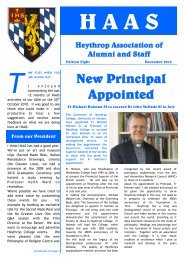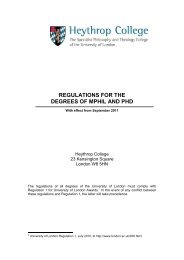Wallace_Stevens.pdf - Heythrop College
Wallace_Stevens.pdf - Heythrop College
Wallace_Stevens.pdf - Heythrop College
Create successful ePaper yourself
Turn your PDF publications into a flip-book with our unique Google optimized e-Paper software.
4<br />
Testament await salvation, and then returns to the earth bringing joy to his flock 7 Moses is a<br />
central figure among those saints in the icon tradition that flows from this myth. The imaginative<br />
power of this section is derives from Biblical themes about Moses who sees God in the burning<br />
bush (‘a lasting visage in a lasting bush’). The bush is the focus for the presence of ‘the real’: a<br />
category traditionally associated with this revelatory moment because when Moses asks God his<br />
name, he is told, ‘I am who I am’ (Ex 3.14), a text read subsequently as a designation of God as<br />
‘Being’, Esse, actuality. Revelation is of the actual, and of course for <strong>Stevens</strong>, although the<br />
designation of ‘the real’ ceases to be construed in religious categories, it continues to be the<br />
disclosure of the real to the person, like Moses, (the poet) who sees it. In ‘An Ordinary Evening in<br />
New Haven’, <strong>Stevens</strong> creates a fictional character, Professor Eucalyptus, who says,<br />
…‘The search<br />
For reality is as momentous as<br />
The search for God.’ It is the philosopher’s search<br />
For an interior made exterior<br />
And the poet’s search for the same exterior made<br />
Interior… 8<br />
It is impossible to read this statement from Professor Eucalyptus without thinking of Aquinas’<br />
designation of God as ipsum esse, ‘being (or reality) itself’: the search for the real is, by definition,<br />
the search for the divine, and Moses before the burning bush finds the divine/real. When God<br />
presents himself, he is identified as ‘the real/reality.’ The revelation culminates at Sinai when<br />
Moses and seventy elders of Israel ‘saw God’ (Ex 24.9-10); Moses demands that God show his<br />
glory, but while he is told that he cannot see God’s face and live (Ex 33.20), he is directed to hide<br />
in the cleft of a rock while God’s glory passes and, as God disappears, Moses will see his ‘back’ as<br />
God leaves.<br />
In another letter of the same year, he writes that ‘the major poetic idea in the world is and always<br />
has been the idea of God’. 9 When Harold Bloom, in his description of ‘the American Religion’,<br />
describes religion as ‘spilled poetry’, he is taking the same line. For <strong>Stevens</strong> and Santayana, our<br />
speech about God is in the same category of ‘speech acts’ as imaginative poetry. Our statements<br />
about God are invented, spun out of the poetic self as a spider produces the filaments that become<br />
its web. God is then in <strong>Stevens</strong>’ words, ‘the supreme fiction’, because ‘the God of religion is a<br />
product of the poetic imagination’. 10<br />
These two modes of perception and expression flow from the same source and are felt by us to be<br />
significant. But why That’s the puzzle. Not simply why do we need them or why do we enjoy<br />
them But why do we produce them Why do we create fictive accounts of the world, even<br />
entertaining the idea of a ‘supreme fiction’ that is solely of our making, the idea of God You will<br />
remember that Descartes thought that the idea of God was planted in us by God himself and that<br />
it is not something that we could have devised. It was Descartes’ way of deflecting the view that<br />
we project the idea of God out of an impulse within us, if it is made by us, it may be of no more<br />
significance than a centaur, a fantastic growth of human imagining. For Descartes, the idea of<br />
God is an effect of God and therefore cannot be dismissed as unsubstantiated.<br />
One of the consequences of <strong>Stevens</strong>’ approach is that if you ask about the meaning of religion, you<br />
are in the same breath asking about the meaning of poetry and imagination. There is an<br />
interesting question about where people ‘locate’ religion’: in relation to what other modes of<br />
expression or disciplines should it be placed The old picture – and I suspect that this a formal<br />
7 Moses is a central figure among the saints pictured in the Orthodox icons of the Descent into hell<br />
that portray this theme.<br />
8 CP, 410.<br />
9 L, 378<br />
10 Bates, op.cit., 52



